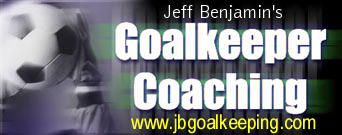
|
"Outstanding keeper instruction. This is a must for goalkeepers and coaches." —Ottawa Internationals S.C. web site, Ottawa, Canada |

|

|
Top |
Goalkeeping Tips, Tidbits and Random Thoughts
An athlete talking to themsleves during competition is hardly a new phenomenon.... The talk does not have to be vocal. By merely thinking you are talking to yourself and sending a message.
-- Tony DiCicco, Goalkeeper Soccer Training Manual
If you have a question, comment or rebuttal you'd like to see addressed here, send me email. I will post your mail to the blog at my discretion unless you specify otherwise.
Even the best can blunder
Even the best in the world sometimes make basic mistakes. The tendency to go backwards is particularly strong, and it is difficult to train goalkeepers to overcome their instincts. And sometimes, even perfect form isn't enough to see you through on the day.Take yesterday's second-leg Champion's League match between Inter FC and AC Milan. On the first goal of the match, by AC Milan's Shevchenko, this picture shows Inter keeper Toldo in good form, weight forward, going low and getting his body in front of the ball. Shevchenko still got the ball by him. At the other end, Milan's Abbiati was shaky at times, often punching balls he should have caught, and on the goal by Inter's Martins -- which was very similar to the Sheva goal -- he started off well, but in the end was completely back on his heels, sprawled with his head back towards his own goal, and the ball in the net.
Unfortunately for Inter and Francesco Toldo, Sheva's goal was the one that counted.
Labels: Matchday observations
Caught with your feet stuck
A reader writes: "My question is regarding the ready position. Often I find myself get caught with "my feet stuck in the ground" and don't react to a shot I know I could dive and save. Could you maybe have any idea of what I may be doing wrong or what I may have to do to keep this from happening?"Paradoxically, when you get "stuck" and can't react, it's often because your feet are moving, not stationary! If you're moving, one foot may not be in contact with the ground, limiting your ability to push off.
There are several things you can do to minimize this. First, use quick footwork to get yourself between the ball and the goal before the shot arrives. This will give you time to properly set yourself. Second, learn to time the shooter and come to the ready position just a bit earlier -- again, you want to be in the ready position before the ball leaves the shooter's foot. Finally, make sure that once you hit the ready position, you are balanced (not cheating to one side or the other) and on your toes with your weight forward.
Labels: Footwork and positioning
What is the proper near-post positioning?
Don't get beat near post. That's what all goalkeepers have heard at one time or another. Protect the near post. Why is that? A couple of reasons stick out: the near post is closer, so shots get there more quickly, and it is also an easier (closer) shot for the attacker if left open. But what is really the proper positioning to stop that near post shot?Tim Fiedler writes: "If the GK keeps himself in the line between the ball and the center of the goal, they will NOT cover the near and far post equally as well. As the ball moves towards one side of the field (or the other), there will be a greater angle open to the near post than the angle to the far post." Then referring to Fig. 2 on the positioning page: "Your diagram actually shows pretty much the proper position for equal coverage.".
Sure enough, the diagram splits the angle neatly in half, covering both sides of the goal, but the "keeper" in the diagram is not along the center line -- he is shifted near post! It turns out that when the ball is "close" to goal -- less than about 8 yards out -- and not dead center, the geometry is such that you do need to shift near post to get the proper angle. This shift gets less pronounced the closer to the center of the field the ball is, and the farther from goal it is. I think most goalkeepers instinctively make this shift, much like I probably did when drawing the diagram for the web site! (You can also use the Right Angle applet to demonstrate this clearly.)
So now we've got another reason to cheat near post. It's where you have to be to have the proper angle for some situations. It's such an old saw, and now that a little high school geometry proved it, I was curious what others said about it. DiCicco refers to the line between the ball and center of the goal as the "ball line", and says all movement should be along this line. No mention of shifting near post. Waiters and Luxbacher don't mention the "ball line" or covering the near post at all; they just talk about moving out to reduce the angle.
Here's my take on it. Being along the center line will put the keeper in good position for most shots, and you should still teach this to your goalkeepers. For beginning goalkeepers, I would probably not mention the near post shift -- they seem to adjust pretty well
naturally, and giving them an exception to the rule for some cases might just confuse them. I can see them cheating too far to the near post and giving up easy far post goals instead. It's a great point to make to more experienced keepers.
Labels: Footwork and positioning